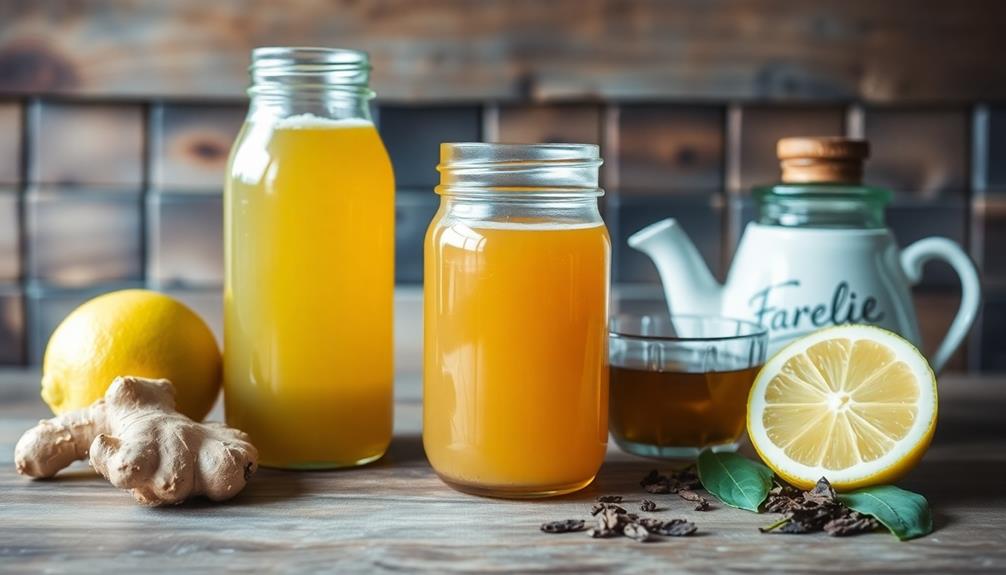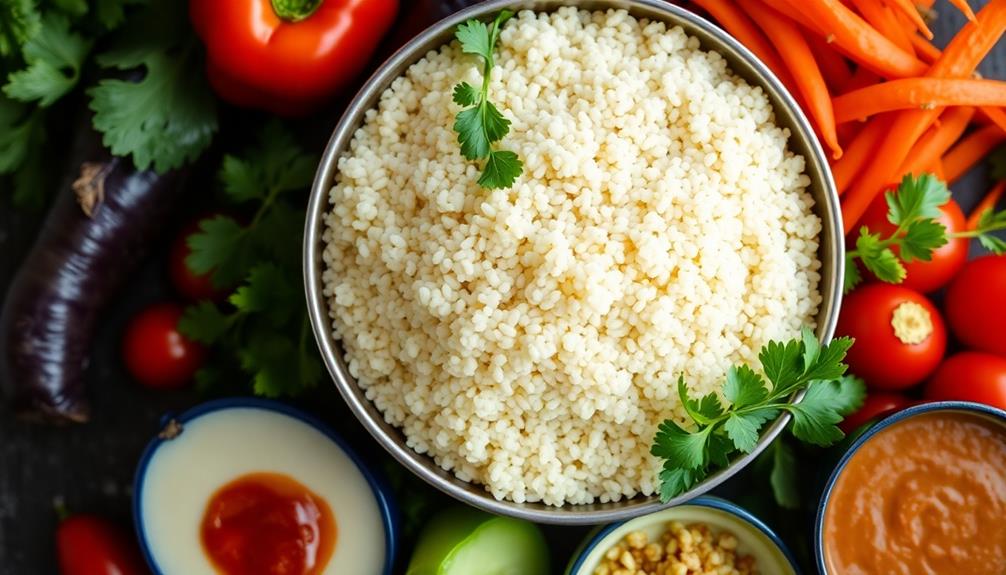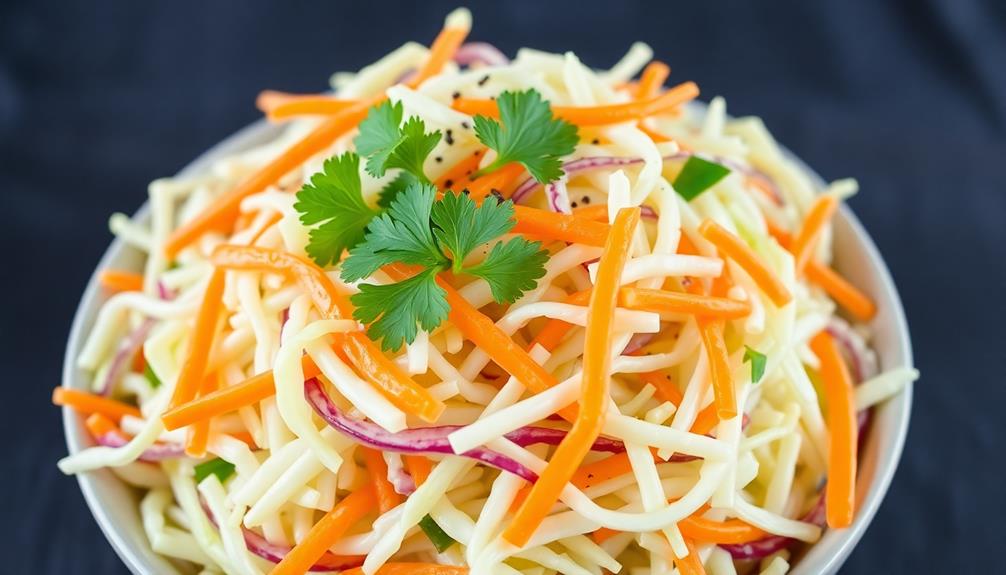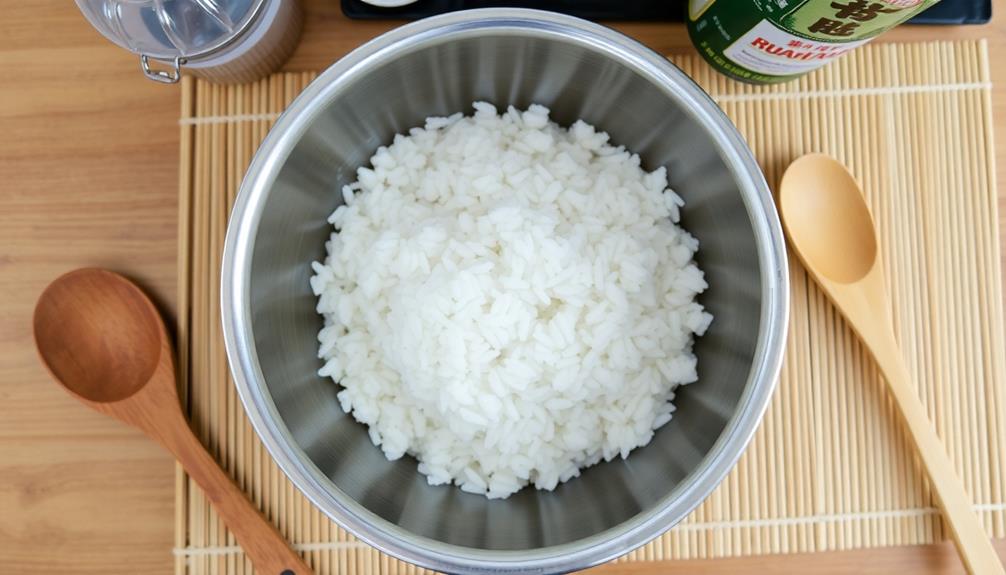Brewing your own kombucha at home is an easy, rewarding, and cost-effective way to enjoy this probiotic-rich beverage. You'll need just a few simple ingredients: water, sugar, black tea, and a kombucha SCOBY. The process involves brewing the sweetened tea, combining it with the SCOBY and starter liquid, and allowing it to ferment for 7-14 days. As the kombucha brews, you can experiment with different flavors by adding fresh fruit, herbs, or juices. Homemade kombucha not only saves you money but also allows you to tailor the taste to your preferences. If you're curious to learn more about the fascinating history and health benefits of this ancient elixir, keep reading. Kombucha has been cherished for centuries, originating in East Asia and spreading globally due to its refreshing taste and potential health-enhancing properties. Once you’ve mastered brewing kombucha, you might also enjoy exploring other fermentation projects, like trying a homemade pickles recipe made easy, to complement your probiotic-rich beverages. Fermentation is a fun and creative way to add depth to your culinary repertoire while promoting gut health with nutrient-packed, flavorful creations.
Key Takeaways
- Gather the essential ingredients: water, sugar, black tea, a SCOBY, and a starter kombucha liquid.
- Brew the sweetened tea, let it cool, then combine with the SCOBY and starter in a clean container.
- Cover the container with a cloth and ferment the kombucha for 7-14 days, tasting periodically.
- Strain the finished kombucha, bottle it, and allow a second fermentation for 2-7 days at room temperature.
- Chill the bottled kombucha before serving to enjoy the refreshing, probiotic-rich beverage.
History

Kombucha, a beverage with ancient roots, has captivated the world with its unique, effervescent flavor and purported health benefits. Originating in Northeast China or Russia, the origins of kombucha can be traced back thousands of years. This fermented tea drink was once considered a "tea of immortality" and was enjoyed by various cultures throughout Asia and Eastern Europe.
In the early 20th century, kombucha began to gain popularity in the West, particularly in Germany, where it was used as a folk remedy for a variety of ailments. As interest in natural, probiotic-rich foods has grown in recent decades, kombucha has experienced a resurgence in popularity around the globe.
Today, this fizzy, slightly tart beverage is widely available in grocery stores and has become a staple in the health-conscious community. With its intriguing history and potential health benefits, it's no wonder kombucha has captured the imagination of people worldwide.
Recipe

Kombucha is a delightfully effervescent fermented tea that has become increasingly popular in recent years. Brewing your own kombucha at home is surprisingly easy and allows you to customize the flavor to your liking. This simple recipe will guide you through the process of creating a refreshing batch of homemade kombucha.
The key to successful kombucha brewing is patience and attention to detail. The fermentation process takes time, typically around 7-14 days, but the end result is well worth the wait. The kombucha SCOBY (Symbiotic Culture of Bacteria and Yeast) is the heart of the brew, acting as a living catalyst to transform sweetened tea into a tangy, probiotic-rich beverage.
Ingredients:
- 8 cups water
- 1 cup granulated sugar
- 6 black tea bags or 4 tablespoons loose-leaf black tea
- 1 kombucha SCOBY
- 1 cup unflavored kombucha (from a previous batch or store-bought)
Instructions:
Bring the water to a boil in a large non-reactive pot. Remove from heat and add the sugar, stirring until dissolved.
Drop in the tea bags or loose-leaf tea and let steep for 5-7 minutes. Remove the tea and allow the sweetened tea to cool to room temperature.
Once cooled, pour the sweetened tea into a clean, non-reactive container, such as a glass or ceramic jar. Gently add the SCOBY and the cup of unflavored kombucha.
Cover the container with a clean cloth or paper towel and secure it with a rubber band. Place the container in a warm, dark location and allow the kombucha to ferment for 7-14 days, tasting it periodically to reach your desired level of tartness.
Tips:
When bottling your finished kombucha, reserve a cup of the liquid to use as the starter culture for your next batch.
The SCOBY will continue to grow and can be shared with friends or family to start their own kombucha brewing.
Experiment with different tea blends, fruit juices, or herbs to create unique and flavorful kombucha variations.
Cooking Steps

First, you'll need to procure a starter culture and some tea.
Then, you'll combine the starter culture and tea, letting it ferment for 7-10 days.
Step 1. Procure Starter Culture and Tea

Gather the essential ingredients for your kombucha-brewing journey: a SCOBY (Symbiotic Culture of Bacteria and Yeast) and black or green tea. The SCOBY is the living, fermenting culture that transforms sweetened tea into the probiotic-rich, effervescent kombucha. You can obtain a SCOBY from a friend who brews kombucha, purchase one online, or grow your own by fermenting a bottle of store-bought kombucha.
Along with the SCOBY, you'll need loose-leaf black or green tea, which provides the nutrients for the culture to thrive. Opt for high-quality, organic tea to ensure the best possible kombucha. Avoid flavored or herbal teas, as they may disrupt the delicate fermentation process.
Once you have your SCOBY and tea, you're ready to begin the kombucha-making process. With patience and attention to detail, you'll soon be sipping on your very own homemade kombucha, brimming with beneficial probiotics and a refreshing, tangy flavor.
Step 2. Combine Starter Culture and Tea

With your SCOBY and tea ready, it's time to get brewing. In a large, clean glass container, combine the cooled black or green tea with the starter culture. The SCOBY should be placed on top, making sure it's fully submerged. Cover the container with a breathable cloth, like a coffee filter or paper towel, and secure it with a rubber band.
It's important to note that the quality of the tea you choose can significantly impact the flavor and fermentation process, so opt for high-quality tea leaves for optimal results. Tea selection for kombucha can enhance your brewing experience.
Now, the fermentation process begins. Place the container in a warm, dark spot, away from direct sunlight. The ideal temperature range is 70-85°F.
Over the next 7-14 days, the SCOBY will consume the sugars in the tea, converting them into acids that give kombucha its distinctive flavor.
Check the brew daily, looking for the SCOBY to grow and the liquid to become more vinegar-like. When it reaches your desired taste, it's time to bottle! Carefully remove the SCOBY, reserving it for your next batch.
Then, transfer the kombucha to airtight containers and enjoy your homemade fermented tea.
Step 3. Ferment for 7-10 Days

Once the SCOBY and tea blend is ready, it's time to let the fermentation process begin. This is where the magic really happens! Over the next 7-10 days, the SCOBY will work its fermentation magic, transforming the sweetened tea into delicious, effervescent kombucha.
To enhance your experience, consider using essential oils like lemon or lavender in your kombucha for added flavor and potential health benefits, such as essential oils for relaxation.
Find a quiet spot in your kitchen to place your fermentation vessel. The ideal temperature range is 70-85°F, so avoid areas that are too hot or cold. Cover the top with a breathable cloth, like a coffee filter or cheesecloth, and secure it with a rubber band. This allows air to flow while keeping out dust and pests.
Let the kombucha ferment for 7-10 days, tasting it periodically. You'll notice the flavor becoming less sweet and more tart as the fermentation progresses.
When it reaches your desired taste, remove the SCOBY and pour the kombucha into bottles for the second fermentation. This carbonates the drink and allows you to infuse it with your favorite fruits or flavorings.
Step 4. Bottle and Refrigerate Kombucha

After the kombucha has fermented for 7-10 days, you'll want to bottle it for the second fermentation. This step allows the kombucha to develop more carbonation and flavor complexity.
First, remove the SCOBY and reserved liquid, then pour the kombucha through a fine-mesh strainer to remove any sediment.
Next, prepare your bottles. You can use swing-top bottles, mason jars, or any other airtight container. Avoid plastic, as it can affect the flavor. Fill the bottles, leaving about an inch of headspace at the top. Add any desired flavorings, such as fruit juice or herbs. Secure the lids tightly.
Now, let the bottled kombucha ferment for an additional 2-7 days at room temperature. This allows the yeast and bacteria to continue converting the sugars, resulting in a more carbonated and flavorful drink.
Step 5. Enjoy the Refreshing Kombucha
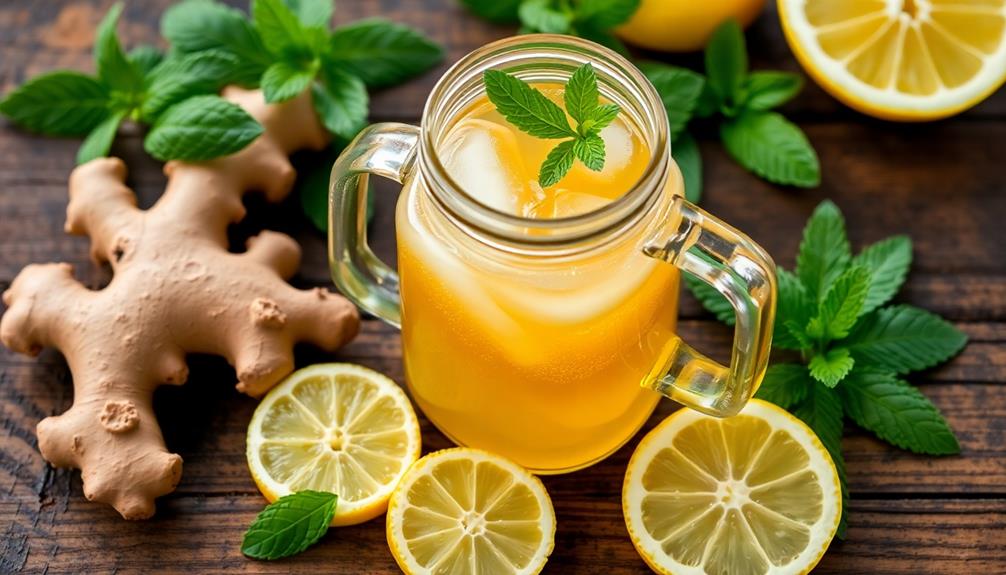
Your homemade kombucha is now ready to enjoy! After refrigerating the bottled kombucha, it's time to dive into this delightful probiotic beverage.
Start by pouring the chilled kombucha into a glass, being careful not to disturb the yeast sediment at the bottom.
The flavor of your kombucha will depend on the tea and any additional ingredients you've added, but you can expect a slightly effervescent, tangy, and refreshing taste. Feel free to experiment with different flavor combinations – you might enjoy adding fresh fruit, herbs, or a splash of juice.
When drinking your kombucha, take your time and savor the unique flavors. You can even try pairing it with a meal or enjoying it as a refreshing afternoon pick-me-up.
The live cultures in the kombucha provide beneficial probiotics, making it a healthy and satisfying beverage choice.
Sit back, relax, and enjoy the fruits of your kombucha-making labor! This homemade elixir is sure to delight your taste buds. Whether you prefer it fizzy or tart, there’s nothing quite like the satisfaction of sipping on your own handcrafted brew. As you savor your kombucha, perhaps you’ll feel inspired to tackle your next kitchen adventure—like learning how to make homemade enchiladas easily. After all, a day filled with tasty, homemade creations is always a day well spent!
Final Thoughts
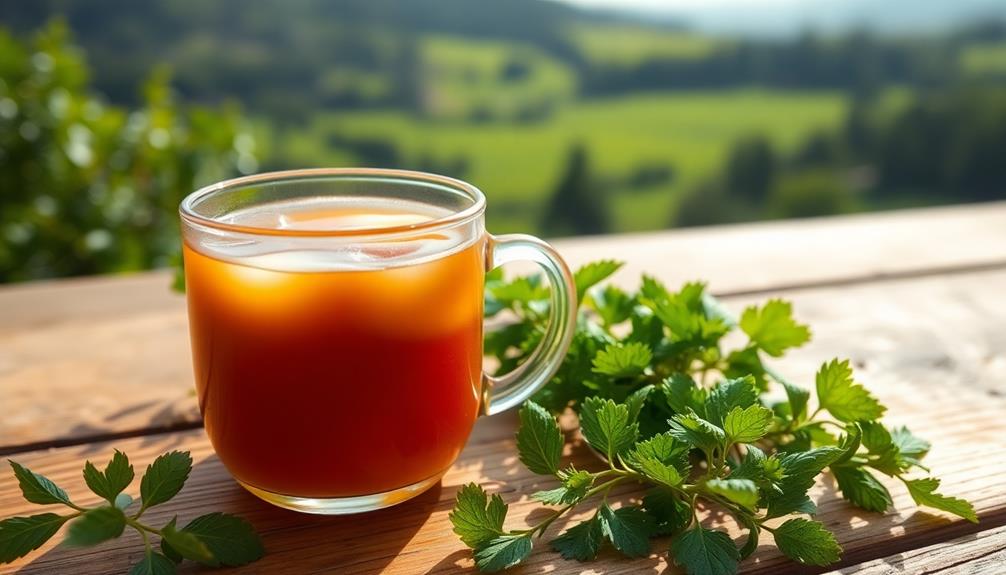
Brewing kombucha at home can be a rewarding and cost-effective endeavor. With the right knowledge and a bit of patience, you can enjoy a steady supply of this delicious and healthful beverage.
While the initial setup may seem daunting, the ongoing maintenance is relatively straightforward, and the payoff is well worth the effort.
As you continue your kombucha-making journey, remember to experiment with different flavors and ingredients to find your perfect blend.
Don't be afraid to try new things – the beauty of homemade kombucha is the ability to tailor it to your personal taste preferences.
Additionally, consider sharing your creations with friends and family, as they're sure to appreciate the time and care you've put into crafting your own kombucha.
Ultimately, embracing the art of kombucha brewing can be a rewarding and enriching experience.
Enjoy the process, savor the flavors, and take pride in your homemade creations.
Frequently Asked Questions
How Long Can Homemade Kombucha Be Stored?
Homemade kombucha can typically be stored for 2-4 weeks in the refrigerator. The exact storage time depends on factors like carbonation levels and how long the kombucha fermented. Be sure to monitor it and consume it before it loses its flavor.
Can Kombucha Be Reused to Make More Batches?
Yes, you can reuse your kombucha to make more batches. After finishing a batch, save a cup or two of the liquid to use as a starter for your next batch. This will help kickstart the fermentation process.
What Are the Health Benefits of Drinking Kombucha?
Drinking kombucha can provide you with a host of health benefits. It's rich in probiotics, which support gut health, and it may also help boost your immune system, reduce inflammation, and even aid in weight management.
Can I Add Fruit or Other Flavors to Kombucha?
Yes, you can absolutely add fruit or other flavors to your kombucha! In fact, doing so can enhance the taste and provide additional health benefits. Get creative with your favorite fruits, herbs, or spices.
Is It Safe to Consume Kombucha During Pregnancy?
Consuming kombucha during pregnancy is generally considered safe, but it's best to consult your healthcare provider first. They can advise you on the potential benefits and risks based on your specific health condition.
